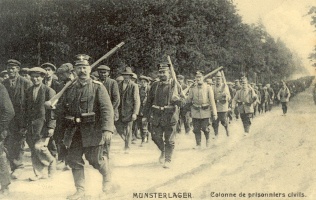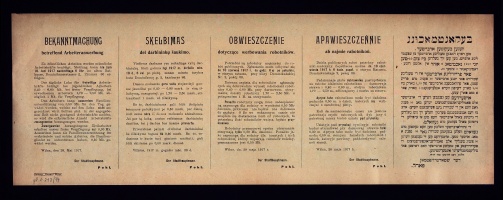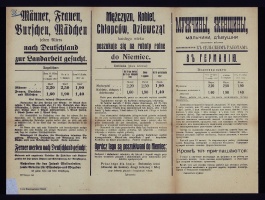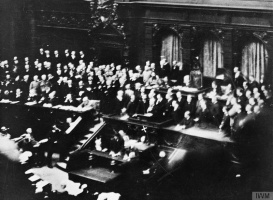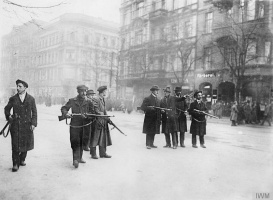Introduction↑
The situation of labor in the German Empire during the years leading up to the war was ambivalent. On the one hand, labor and the labor movement were still on the advance. The Social Democratic Party (SPD) had just won the Reichstag elections of 1912 with almost 35 percent of the popular vote and had become the strongest parliamentary group. The socialist unions (Freie Gewerkschaften) counted 2.5 million dues-paying members in 1913, with the Christliche Gewerkschaften (340,000) and the liberal Gewerkvereine (110,000) a distant second and third. After the turn of the century the unions had embarked on a successful campaign to spread bilateral collective labor agreements with employers, especially in the small- and medium-sized industries of the German southwest. In 1913, more than 1.2 million German workers were employed under such collective regulations. The unions prided themselves on a growing number of “wage initiatives” that wrested concessions from employers short of an actual walkout. As a consequence, wages had risen modestly but steadily over the last decade before the war.
On the other hand, the climate in German industrial relations had changed for the worse before 1914. Employers’ resistance had stiffened. In 1904, two umbrella organizations had been founded in order to unite the forces of the employers’ associations in both heavy and consumer industries. In 1913, they merged to form the Vereinigung Deutscher Arbeitgeberverbände. The new employers’ organizations launched a counteroffensive against the unions’ strategy to foster collective labor agreements. They refused negotiations with employees’ organizations in general and retaliated against strikes or even strike threats with extended lockouts. Despite the unions’ prudent and conciliatory tactics, the period between 1906 and 1911 was the most intense in terms of strike activity and lockouts.[1]
On the eve of the war, the German government was faced with the task of pacifying an incalculable inner opponent and bringing the workers – or at least their leaders – in line with the war effort. Within German Social Democracy, the reformist wing had strengthened over the past decade, but the socialist left was still a lively and eloquent force with which to reckon. The unions’ leadership had developed a steadfast pragmatist attitude, but the employers’ campaign against collective negotiations had contributed its share in stoking up “class warfare” – from above.
The Reich’s authorities’ aim was to prevent Social Democratic obstruction of the war credits in the Reichstag and ensure a certain degree of collaboration on the side of the unions. In contrast to Great Britain and France where leaders of the Labour Party and the Socialist Party were appointed to the respective war cabinets and union functionaries became involved in the management of the war economy, the Reich kept Social Democrats and union officials at arms’ length. Their inclusion in the war effort was more a matter of symbolic politics, making them the prime addressee of the Kaiser’s “party truce policy” (Burgfriedenspolitik) and soliciting the workers’ loyalty by selling them the conflict as a defensive war caused by an aggressive Russia.[2]
Development of the Workforce↑
Initially, the German economy was not geared to meet the requirements of a war economy at all. Since most authorities involved believed the war would be won and over in a matter of months, neither the military administration of the homeland territories nor industry were prepared to set up a sustainable, highly complex, centrally coordinated machinery able to provide an army of 8 million men with a sufficient number of guns, tons of ammunition, and daily supplies for years. In Germany, this situation was aggravated when the English naval blockade went into unexpected effect and cut off the Reich from the raw materials needed for blasting agents. The ensuing “ammunition crisis” in November 1914 – when stocks of artillery grenades were down to six days – ended a period of laissez faire that was replaced by forms of employers’ self-organization, such as the War Raw Materials Department (Kriegsrohstoffabteilung), a bureau of the war ministry staffed with civilian experts from industry, and an increasing encroachment of military authorities on private enterprises.[3]
Although the structure of the German workforce changed profoundly throughout the four years of war, it did so without a clear plan delineating unanimous priorities. Neither a possible maximum extraction of male workers in order to swell the ranks of military reserves, nor a dedicated expansion of the war economy in terms of labor in order to meet the rising military demand for war material, nor a distinct rationalization of the war economy were recognizable. In peacetime, the German draft system had circumvented many young male workers in industrial centers such as the Ruhr because authorities feared their political unruliness and a potential revolutionary mutiny. Only recently had the less traditional German navy begun drafting more of these men whose mechanical training its commanders could put to use on the Kaiser’s high-tech vessels. This meant that hundreds of thousands of industrial workers in Germany were initially not subject to mobilization. Most of them, especially in heavy industry, in coal mining and the chemical industries were claimed as irreplaceable on reserved occupation afterwards.
Other occupational groups bore the brunt of recruitment for the frontlines. In 1917, more than 50 percent of all self-employed masters of the crafts were mustered, with the effect that many of their workshops had to close down. This, in turn, swelled the ranks of the unemployed. The same was true for agricultural personnel. By 1918, 50 percent of all German men between fifteen and sixty years of age were conscripted, with the industrial workers contributing only a minor share.
Thus, of the 5.4 million male workers in German industry in 1913 (that is, in workshops employing ten or more workers), only about 25 percent were lost – most due to conscription – by 1918. Whereas early employment of young males under the age of sixteen remained negligible, female employment rose significantly from 1.4 million in 1913 to 2.1 million in 1918, a leap of 52 percent. Yet still the overall size of the workforce – men, women, and adolescents taken together – hovered between 7.4 million in 1913 and 6.8 million in 1918, which meant a loss of 8 percent – a rather bad record for the mobilization efforts of a war economy. Consequently, a chronic scarcity, especially of skilled workers in heavy industry and in weapon production, crippled all attempts by the German authorities to substantially increase output.
Still, there was a remarkable shift of the workforce in general towards the “war relevant industries.” This cluster, which embraced the heavy industries as well as metalworking, machine building, electronics, and the chemical and oil industries, counted 44 percent more workers in 1918 than it had in 1913. The so-called “peacetime industries,” including food processing and textiles, lost 40 percent of their workforce during the same time span. “Intermediate industries” such as mining (other than coal) and construction forfeited about 20 percent of their staff. Most of these structural shifts were only accomplished during the second half of the war, side effects of the belated big government programs designed to increase military production.[4]
These shifts were the effects of comprehensive attempts by the German authorities to restructure and redirect the workforce, which nevertheless failed to reach their objective. The forced closure of small workshops and factories, especially in remote regions, proved premature in many cases. Especially in the case of food processing, the authorities woke up much too late to the fact that this trade might be relevant to the war as well. In addition, instead of channeling the laid-off workers into the war industries, unemployment mounted up. Many workers made redundant by plant closings refused to move into the industrial centers. Fluctuation rates remained notoriously high.
“Auxiliary Service Law” (Hilfsdienstgesetz) and “Hindenburg program”↑
The Auxiliary Service Law (Gesetz über den vaterländischen Hilfsdienst) of 5 December 1916 declared an obligation to work for all male Germans between seventeen and sixty years of age in war-relevant establishments. These now included agricultural farms, hospitals, and public administration. Envisioned as an extension of the compulsory military service, the Hilfsdienstgesetz rather developed into a pacifying instrument vis-à-vis the labor movement. Thus after two years, the brittle, merely symbolic “Burgfrieden” had to be replaced by substantial concessions towards the Social Democratic Party and the trade unions, including a small piece of co-administration.
As the law had to pass the Reichstag, a “left” majority comprising the Social Democrats and the Catholic Center Party softened the regulations intended to curb workers’ fluctuation. It also introduced arbitration committees where employers and union delegates were equally represented. In one of the most consequential provisions in the long run – see the Betriebsrätegesetz of 1920 – the law provided for the obligatory establishment of workers’ and white collar employees’ committees in industrial establishments of fifty employees or more. They had the right to file collective grievances with the arbitration committees.
As important as the Hilfsdienstgesetz was to ensure the labor movement’s loyalty to the war effort for a while longer – it fell short of mobilizing additional sources of labor for the hard-pressed war economy. In Wurttemberg, for example, a state that had about 350,000 men fighting on the frontlines or manning fortifications, 116,000 industrial workers were conscripted for the military between January 1917 and October 1918. They were replaced by 125,000 persons, of whom only a quarter were recruited under the Hilfsdienstgesetz, the remainder being women (70 percent) and very young or very old males (6 percent). Of those falling within the jurisdiction of the law, half would be employed in agriculture, as many as in industry proper.[5]
The law was initially intended to flank the “Hindenburg Program”, an ambitious plan devised by the Supreme Army Command (Oberste Heeresleitung) upon its appointment on 31 August 1916. The plan dictated almost utopian increases in the production figures for artillery guns of all sorts, machine guns, fighter planes and ammunition. Immediately, in the fall of 1916, comprehensive activities for the construction of additional plants and factories commenced without proper means to man them with qualified personnel. At the other end of the spectrum, the closings of allegedly “unimportant” production facilities sped up. A transportation crisis was the immediate effect, which also caused a serious shortage of coal. Thus the Supreme Army Command had to soft-pedal its demands and to settle for a better average utilization of existing establishments. Only in the fall of 1917 were production benchmarks scheduled for spring met. And only in the winter of 1917/1918 did the envisioned conversion to a full-fledged war economy gain traction. Yet the Supreme Army Command was never willing to really share powers with the representatives of industry, who busied themselves with criticism all along the way.[6]
Wages, Working Conditions and Living Standards↑
Since all government measures did not eliminate the chronic scarcity of skilled workmen in the key sectors of the war economy, the corporations continued to compete for them using wage incentives. This led to a doubling of the average yearly nominal income for male workers in industry until September 1918. Workers in the war-relevant industries profited disproportionally, with employees in the electronic industry almost tripling their yearly nominal income. Although other trades had to follow the trend at least as much as they could in order to keep the outflow of their workforce at bay, the gap between the best and the worst paid male workers widened considerably. Whereas a highly skilled toolsetter in a Berlin gun factory might have earned twenty-five marks a day, his colleague in a small town weaving mill went home with three and a half marks.
Wage gains, at least in terms of percentages, were even larger for women. On average, women’s wages in the war-relevant industries rose by 186 percent between 1914 and 1918. Much of this was a basis effect, however, since the pay for female workers for the same kind of work had been calculated by the authorities at a third or more less than that for their male colleagues. Complaints about this unjust treatment were endemic and, coupled with sick leave, fluctuation and absenteeism, contributed to a piecemeal catching up of nominal wages. Yet it rather points to the limits of the government measures that wages for female work rose most in the metalworking industry, which provided the least desirable workplaces for women.[7]
Under these circumstances, working conditions deteriorated particularly during the years after 1916. Very often, the staff on the shop floor of a metalworking plant in 1917 was rather ragtag because of fluctuations and the ad hoc assignments of “Hilfsverpflichtete,” adolescents, and women. The mills were understaffed, especially during the unpopular night shifts, when absenteeism ran high. The canteens’ menus made workers – male and female alike – disgruntled when they again featured nothing but turnips – with potatoes or not – for weeks on end. Malnutrition and an ill-composed diet became common. This added to a chronic fatigue especially among those not accustomed to regular night shift work. Whole shifts, contemporaries observed, were spent with cursing and dozing and killing time rather than working, especially if the foreman or supervisor was absent – or took part in the game.
Although German workers did not suffer from the extreme depreciation of their monetary income like the recipients of fixed salaries, such as officials in public administration, or set pensions, their nominal wage increases were surpassed by inflation rates ever faster as the war went on. Again, 1916 seems to have been the decisive year for the start of a quickly accelerating inflationary process. This was mainly due to the fact that the Reich financed the war effort largely by actuating the money printing press. Reich authorities and the military fuelled the process further by granting the industry generous prices for armament supplies. In contrast to the United States and the United Kingdom, furthermore, the Reich refrained from shaving off accumulating profits and ensuing excessive purchasing power by introducing wartime taxes or adjusting the progression of the income tax. Measured against the official cost of living index, the average male worker employed in the armament industries lost almost 23 percent of his yearly real income between 1914 and 1918 – despite all nominal wage gains. Employees in the intermediate industries had to endure losses of 36 percent, those in the so-called “peacetime industries” even of 44 percent. For women, the real income losses ran slightly lower, especially in the war-relevant industries, where the scarcity even of female workers after 1916 dictated massive wage incentives. In these sensitive sectors, employers started to resort to a remuneration policy – for example paying lump premium bonuses – which was at least remotely aligned with the rising costs of living. However, this did not prevent a considerable impoverishment of the entire German workforce in a financial sense as compared to the years leading up to the war, as well as to the few years of economic reconstruction starting after the period of hyperinflation had ended in 1924.[8]
Another factor that caused prices to spiral upwards was the scarcity of goods. Here the English naval blockade was instrumental as far as imports were concerned. Yet in many ways, the shortages, especially of essentials, were homemade. They partly resulted from the authorities’ premature closings of small businesses and food processing plants. The most severe austerity, however, was due to the authorities’ incapacity to force agricultural cultivators to sell their produce under a price cap. Rather than complying with not-to-exceed prices, farmers began hoarding their commodities until they were able to channel them into the black market. Thus essential foodstuff was not only withheld from the official rationing system, but the black economy also kept these much needed goods out of reach of workers with a monetary income insufficient to supplement their diet in the shadow economy. The official rationing system in Germany was hard pressed to guarantee the provision of the German population with basic supplies and was on the brink of virtual collapse in the winter of 1916/1917. The “turnip winter” (Kohlrübenwinter) of 1916/1917 was a traumatic experience, but the low point in the supply situation was reached in the summer of 1917, when most consumers had to survive on 1,000 calories a day. Malnutrition, especially for children and adolescents, became widespread and youth became predisposed to diseases such as nutritional edema. Mortality rates among the elderly rose significantly. Some regions even became famine-stricken. German workers experienced these hardships as a polarizing of society, with the bulk of the population overworked and underfed on the one end and the rich, whose affluence bought even luxurious items in the black market, on the other. No other factor than the supply situation contributed more to the loss of morale and the growing disloyalty to the war effort of German workers after 1916.[9]
Social Democracy: Split and Road to Power↑
The Social Democratic Party was factually split over the attitude to the war almost from 4 August 1914 on. As almost everywhere in Europe, socialism in Germany tended to drift apart into a patriotic pro-war wing, an anti-war current, and a radical left grouping aiming at turning the war situation over into a socialist revolution. Yet this internal rift could be camouflaged initially – with the early exception of Karl Liebknecht (1871-1919) – in unanimous votes for the war credits until December 1915. The prolonged war and the expanding public discussion of aggressive war objectives brought the symbolic “Burgfriedenspolitik” to an end. In December 1915, twenty SPD Reichstag members refused to vote for new war credits. In March 1916, a qualified minority within the SPD Reichstag faction distanced themselves from the majority decision to back a government-proposed emergency budget. The majority reacted harshly and immediately expelled the dissenting minority voters from the faction in a rigid attempt to enforce party discipline regarding its stance towards the war effort. In January 1917, a National Conference of the party opposition was held; its participants in turn faced expulsion from the majority party’s ranks.
After the formally excluded minority delegates had united in a Sozialdemokratische Arbeitsgemeinschaft, an informal grouping, as early as March 1916, the center-to-left opponents formed a Reichstag section of their own on 19 January 1917, and on 7 April 1917 the Independent Social Democratic Party (USPD) was formally established. SPD locals were encouraged and forced to choose between affiliations. Support for the USPD at the party basis came predominantly from Berlin, Frankfurt, Brunswick and the strongholds of the left party wing in Saxony. Nevertheless, the now formal split of German Social Democracy was not primarily a matter of ideological factionalism, pitting a left-wing USPD against the center-to-right Majority Social Democratic Party (MSPD). The position for or against the war had united diverse party functionaries such as the “revisionist” Eduard Bernstein (1850-1932) and the “centrist” orthodox Marxist Karl Kautsky (1854-1938) as early as 1914. Rather, there was the increasingly bitter conflict over the issue of the SPD’s war support and draconian policies, pitted against the Reichstag dissenters challenging the course of the “Burgfrieden” which made the rift inevitable.[10]
The MSPD maintained its policy of loyalty to the war effort neither out of patriotic blindness nor out of self-serving intra-party authoritarianism. For the Reichstag majority, compliance with the “Burgfrieden” and maintaining party discipline were necessary stepping stones for its envisioned participation in parliamentary legislation on an equal footing and eventually for the transformation of the Reich into a parliamentary regime. The MSPD managed to gain parliamentary influence despite its prolonged isolation by the liberal, conservative, and center factions, reinvigorating informal contact with bourgeois reform circles from the years before 1914.[11] In 1917, the MSPD formed an alliance with the bourgeois parties of the political center, which became institutionalized in the Inter-Factional Committee (Interfraktioneller Ausschuss) of the Reichstag. In October 1918, the MSPD finally entered the first German government accountable to the parliament under the newly appointed chancellor Max von Baden (1867-1929). The successful strive for power came with the price of a substantial alienation of the leading party circles from the party’s basis. Many workers resented the continued support of the majority party for the war effort, which for them was a major factor in prolonging a potentially life-threatening conflict. Workers increasingly turned toward the dissenting party, whose opposition to the war and the one-sided separate peace with the young Soviet Union at Brest-Litovsk was manifest. The USPD won over more than 120,000 members by the fall of 1917.
In the revolution after the armistice on 11 November 1918, the MSPD and the USPD collaborated in the short-lived new government agency, the Rat der Volksbeauftragten. Deep dissension about the future constitutional layout of the new republic caused the USPD to revoke its government participation by the end of December 1918. In December 1920, the left wing of the USPD joined the Communist Party (KPD), which had been established by the Spartakusbund and other left-wing radical groups at the end of 1918. The remainder of the USPD reunited with the MSPD in September 1922.[12]
Opposition, Protest, and a Restrained Revolution: The Shopfloor Movement and the Unions↑
In the meantime, within the working population, public sentiment had turned sharply against the Reich authorities so that contemporary observers could speak of a “pre-revolutionary climate” in German industrial centers by 1917. The paramount reason for this disintegration of morale and support for the war was the dismal supply situation. A chronically overworked and underfed workforce with women often bearing the brunt of supplementing meager compensations for their husbands’ military service or war-invalidity had grown war-weary. Negative sentiment among workers in Germany received a profound political twist with the signing of the separate peace treaty at Brest-Litovsk on 3 March 1918. In their eyes, the harsh conditions of this diktat agreement underscored both the Reich’s strategy to prolong the war at all cost and its intention to drain the livelihoods from the young, post-revolutionary Soviet Union.
The second half of 1917 saw a growing wave of walkouts combined with protest marches in the streets. This development culminated in the ammunition workers’ strike in January 1918 involving about 1,000,000 employees in the Reich, with more than 400,000 participants in Berlin alone, whose delegates established one of the first workers’ councils. The strike was called and organized by the “revolutionary shop stewards” (Revolutionäre Obleute), and not by the trade unions holding jurisdiction over the trade. This became emblematic for a trend in which workers on the shopfloor level in large industrial establishments emancipated themselves from the unions, whom they considered increasingly as opportunistic disciplinary instruments co-enforcing the statutes of the Hilfsdienstgesetz. The core of this grassroots’ movements with a strong tendency to cluster at the individual workshops consisted of skilled male workers and their immediate superiors. They reacted to a severe deterioration of their own status, effected by declining real wages, the prolongation of working hours, and an increasingly harsh work discipline introduced to adapt to the influx of new elements in the workforce such as women, very young and very old males, and migrants from the agricultural regions of the Reich. Also, in some sectors of the industry, forced labor from the occupied territories and from the ranks of prisoners of war had to be integrated into a production process hampered by shortages of resources, malnutrition and fatigue. On the other hand, even skilled workers considered indispensable on the shopfloor faced the continued risk of being conscripted to the frontlines after all. However, organization at the workshop level also had the very pragmatic rationale that questions of food supply were best negotiated directly with the local management, which replaced the state and communal institutions as a force able and willing to provide for their workforce. In some industries, such as the chemical industry of the Rhineland, workers and managers jointly constituted the first workers’ councils.[13]
The grassroots’ movement in the factories was a mixed blessing for the trade unions. On the one hand, it showed the growing unrest among the workers and thereby provided for a formidable scenario of intimidation. On the other hand, the wildcat strikes undermined the unions’ authority to control their own workforce. The attempts to formally establish the unions as collective bargaining agents recognized by industry thus were postponed until 15 November 1918, when the Stinnes-Legien-Agreement was signed. The shopfloor movement, culminating in the spread of workers’ and soldiers’ councils all over Germany, did not result in a revolutionary twist toward a Soviet Germany. The revolutionary shop stewards and other representatives from the ranks of the skilled male workers turned out to be militant at the point of production but rather pragmatic on the political level. This united German workers with their comrades in other European countries. The German congress of shop stewards opted for a democratic republic with a representative parliament rather than a German Soviet republic.[14]
The revolution finally started with the upheaval in the German navy. Since many young male workers from the industrial centers such as the Ruhr had been assigned to the navy when they were conscripted, the mutiny of the German fleet in November 1918 and the ensuing formation of workers’ and soldiers’ councils in the coastal cities quickly spread to Berlin, Munich, Hamburg, Bremen, the Ruhr and Saxony, thus triggering the revolution.[15]
Thomas Welskopp, Bielefeld University
Section Editor: Christoph Cornelißen
Notes
- ↑ Figures in: Kocka, Jürgen: Klassengesellschaft im Krieg. Deutsche Sozialgeschichte 1914-1918, Frankfurt am Main 1988, p. 202.
- ↑ See: Kruse, Wolfgang: Krieg und nationale Integration. Eine Neuinterpretation des sozialdemokratischen Burgfriedensschlusses 1914/15, Essen 1993.
- ↑ Ullmann, Hans-Peter: Kriegswirtschaft, in: Hirschfeld, Gerhard / Krumeich, Gerd / Renz, Irina (eds.): Enzyklopädie Erster Weltkrieg, Paderborn et al. 2004, pp. 220-232; 222f.
- ↑ Cf. Kocka, Klassengesellschaft 1988, pp. 27f.
- ↑ Mai, Gunther: Hilfsdienstgesetz, in: Hirschfeld/Krumeich/Renz, Enzyklopädie 2004, pp. 553f.
- ↑ Geyer, Martin H.: Hindenburg-Programm, in: Hirschfeld/Krumeich/Renz (eds.), Enzyklopädie 2004, pp. 557f.
- ↑ Cf. Kocka, Klassengesellschaft 1988, pp. 29ff.
- ↑ Bry, Gerhard: Wages in Germany 1871-1945, Princeton 1960, pp. 206f.
- ↑ Geary, Dick: Arbeiter, in: Hirschfeld/Krumeich/Renz (eds.), Enzyklopädie 2004, pp. 142-154; 147.
- ↑ Berger, Stefan: Social Democracy and the Working Class in Nineteenth and Twentieth Century Germany, Harlow et al. 2000, pp. 91f; Wheeler, Robert F.: USPD und Internationale. Sozialistischer Internationalismus in der Zeit der Revolution, Frankfurt am Main 1975; for an inside view see: Benz, Wolfgang/Graml, Hermann/Wheeler, Robert F. (eds.): Die revolutionäre Illusion. Zur Geschichte des linken Flügels der USPD. Erinnerungen von Curt Geyer, Munich 2010.
- ↑ See: Ratz, Ursula: Zwischen Arbeitsgemeinschaft und Koalition. Bürgerliche Sozialreformer und Gewerkschaften im Ersten Weltkrieg, Munich 1994.
- ↑ Miller, Susanne: Burgfrieden und Klassenkampf. Die deutsche Sozialdemokratie im Ersten Weltkrieg, Düsseldorf 1974, p. 420.
- ↑ Berger, Social Democracy 2000, p. 92. For the iron and steel industry cf. Welskopp, Thomas: Arbeit und Macht im Hüttenwerk. Arbeits- und industrielle Beziehungen in der deutschen und amerikanischen Eisen- und Stahlindustrie von den 1860er bis zu den 1930er Jahren, Bonn 1994.
- ↑ See: von Oertzen, Peter: Betriebsräte in der Novemberrevolution, Bonn 1976.
- ↑ Hagenlücke, Heinz: Arbeiter- und Soldatenräte, in: Hirschfeld/Krumeich/Renz (eds.), Enzyklopädie 2004, p. 340.
Selected Bibliography
- Benz, Wolfgang / Graml, Hermann / Wheeler, Robert F. (eds.): Die revolutionäre Illusion. Zur Geschichte des linken Flügels der USPD. Erinnerungen von Curt Geyer, Munich 2010: Oldenbourg Wissenschaftsverlag.
- Berger, Stefan: Social democracy and the working class in the nineteenth and twentieth century Germany, Harlow; New York 2000: Longman.
- Bieber, Hans-Joachim: Gewerkschaften in Krieg und Revolution. Arbeiterbewegung, Industrie und Militär in Deutschland 1914-1920, Hamburg 1981: Christians.
- Daniel, Ute: Arbeiterfrauen in der Kriegsgesellschaft. Beruf, Familie und Politik im Ersten Weltkrieg, Göttingen 1989: Vandenhoeck & Ruprecht.
- Feldman, Gerald D.: Armee, Industrie und Arbeiterschaft in Deutschland, 1914 bis 1918, Berlin 1985: J. H. W. Dietz.
- Geary, Dick: Arbeiter, in: Hirschfeld, Gerhard / Krumeich, Gerd / Renz, Irina (eds.): Enzyklopädie Erster Weltkrieg, Paderborn 2003: Schöningh, pp. 142-154.
- Kocka, Jürgen: Klassengesellschaft im Krieg. Deutsche Sozialgeschichte 1914-1918, Göttingen 1973: Vandenhoeck & Ruprecht.
- Kruse, Wolfgang: Krieg und nationale Integration. Eine Neuinterpretation des sozialdemokratischen Burgfriedensschlusses 1914/15, Essen 1993: Kartext Verlag.
- Mai, Gunther: Arbeiterschaft in Deutschland, 1914-1918. Studien zu Arbeitskampf und Arbeitsmarkt im Ersten Weltkrieg, Düsseldorf 1985: Droste.
- Miller, Susanne: Burgfrieden und Klassenkampf. Die deutsche Sozialdemokratie im Ersten Weltkrieg, Düsseldorf 1974: Droste.
- Oertzen, Peter von: Betriebsräte in der Novemberrevolution. E. politikwiss. Unters. über Ideengehalt u. Struktur d. betriebl. u. wirtschaftl. Arbeiterräte in d. dt. Revolution 1918/19, Bonn-Bad Godesberg 1976: Dietz.
- Offer, Avner: The First World War. An agrarian interpretation, Oxford; New York 1989: Clarendon Press; Oxford University Press.
- Ratz, Ursula: Zwischen Arbeitsgemeinschaft und Koalition. Bürgerliche Sozialreformer und Gewerkschaften im Ersten Weltkrieg, Munich 1994: K.G. Saur.
- Ritter, Gerhard A. / Miller, Susanne: Die deutsche Revolution 1918-1919. Dokumente, Frankfurt a. M.; Hamburg 1968: Fischer.
- Schönhoven, Klaus: Die Gewerkschaften in Weltkrieg und Revolution 1914-1919, Cologne 1985: Bund-Verlag.
- Welskopp, Thomas: Arbeit und Macht im Hüttenwerk. Arbeits- und industrielle Beziehungen in der deutschen und amerikanischen Eisen- und Stahlindustrie von den 1860er bis zu den 1930er Jahren, Bonn 1994: J. H. W. Dietz.
- Wheeler, Robert F.: USPD und Internationale. Sozialistischer Internationalismus in der Zeit der Revolution, Frankfurt a. M. 1975: Verlag Ullstein.





